Qualcomm Bundle
Who Really Controls Qualcomm's Future?
Delving into the Qualcomm SWOT Analysis reveals the critical importance of understanding its ownership structure. The complex web of shareholders, executives, and institutional investors dictates Qualcomm's strategic direction and its ability to navigate the ever-evolving landscape of the tech industry. Unraveling who owns Qualcomm is key to grasping its market position and future potential.
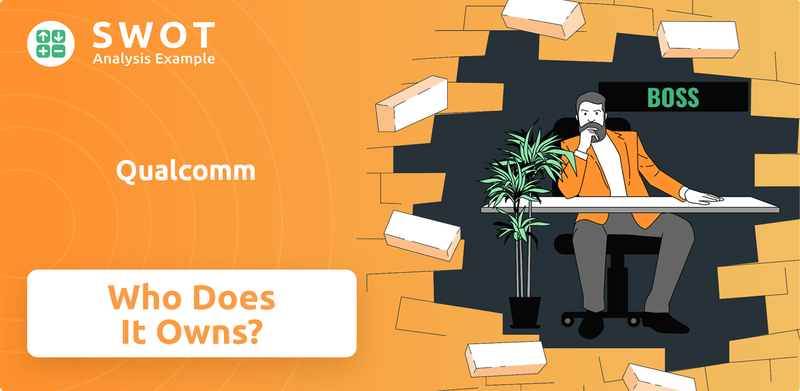
Understanding the Qualcomm ownership structure is crucial for investors and industry watchers alike. From its founding to its current status as a global technology leader, the evolution of Qualcomm's shareholders has shaped its trajectory. This exploration will examine the key players in Qualcomm's ownership, including its public shareholders, major investors, and the influence of its executives, providing insights into the company's governance and long-term strategy. Knowing the Qualcomm parent company and its history is essential.
Who Founded Qualcomm?
The genesis of the company began in July 1985, with seven co-founders. These individuals, largely former employees of Linkabit, a company also co-founded by Irwin Jacobs and Andrew Viterbi, laid the groundwork for what would become a technology giant. The company's early focus was on research and development, particularly in the realm of wireless communication.
The founders' vision, encapsulated in the name 'Quality Communications,' set the tone for the company's mission. Their expertise, combined with a strategic focus on Code Division Multiple Access (CDMA) technology, positioned the company for future success. The initial operations were centered on contract research and development, with a particular emphasis on government and defense projects.
Early funding for the company's research into CDMA technology was generated through the sale of Omnitracs, a two-way mobile digital satellite communications system. In 1988, Qualcomm merged with Omninet, securing $3.5 million in funding specifically for the Omnitracs system aimed at trucking companies. While specific equity splits at the company's inception are not publicly detailed, the founders' collective expertise and their prior success with Linkabit were instrumental in attracting initial capital and shaping the company's early direction. The founding team's strong conviction in CDMA technology, despite initial industry skepticism, was a defining aspect of their early control and strategic focus.
The primary founders of the company included Irwin Jacobs, who served as CEO, and Andrew Viterbi, who was the CTO. Other key founders were Franklin Antonio, Adelia Coffman, Andrew Cohen, Klein Gilhousen, and Harvey White. Their combined expertise and vision were crucial in the early stages. The early focus was on contract research and development, and the company initially concentrated on government and defense projects. The company's early funding was generated through the sale of Omnitracs, a two-way mobile digital satellite communications system. The company's history showcases the importance of visionary leadership and early strategic decisions. Learn more about the Revenue Streams & Business Model of Qualcomm.
- Irwin Jacobs: CEO and electrical engineering background.
- Andrew Viterbi: CTO.
- Early Funding: Generated through the sale of Omnitracs.
- Initial Focus: Contract research and development.
Qualcomm SWOT Analysis
- Complete SWOT Breakdown
- Fully Customizable
- Editable in Excel & Word
- Professional Formatting
- Investor-Ready Format
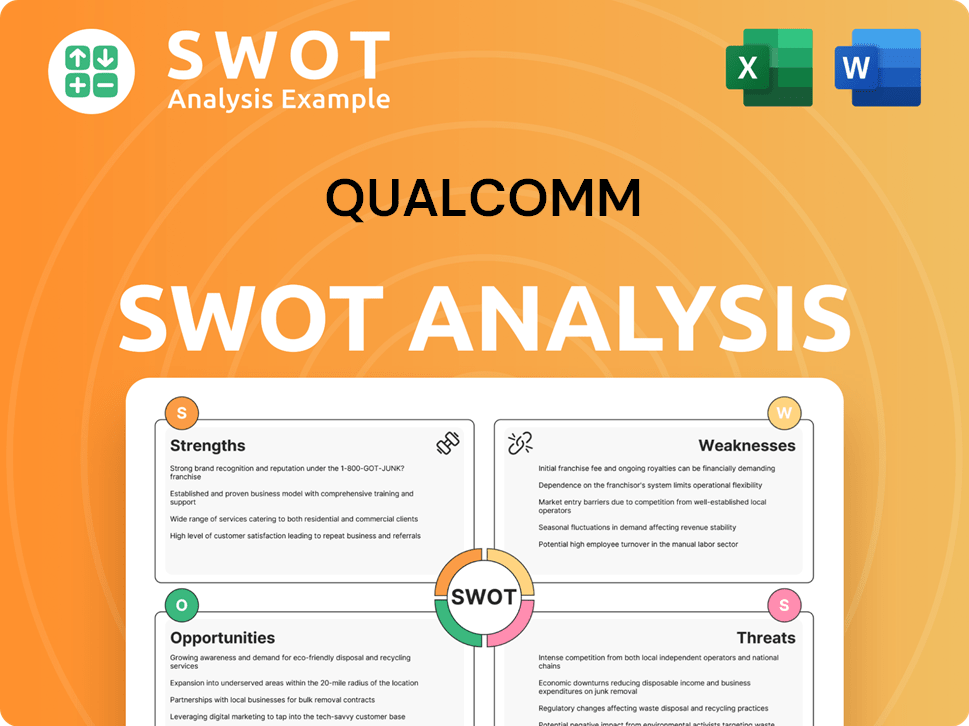
How Has Qualcomm’s Ownership Changed Over Time?
The evolution of Qualcomm's ownership has been marked by significant shifts since its inception. Initially a privately held entity, the company transitioned to a publicly traded status on the Nasdaq Stock Market, trading under the symbol 'QCOM'. This move broadened its ownership base, attracting a diverse group of institutional and individual investors. As of June 6, 2025, institutional investors hold approximately 74.03% of the outstanding shares, reflecting a strong influence from large financial entities on the company's strategic direction and governance.
Key events have significantly impacted the ownership structure of Qualcomm. The initial public offering (IPO) was a pivotal moment, opening up access to its shares to the public. Furthermore, Qualcomm has actively engaged in share buyback programs. For example, between December 30, 2024, and March 30, 2025, the company repurchased 10.686 million shares for about $1.74 billion. In the second quarter of fiscal 2025, Qualcomm returned $2.7 billion to stockholders, including $1.7 billion through the repurchase of 11 million shares. These actions have altered the number of outstanding shares and, consequently, the ownership percentages of various stakeholders.
| Ownership Category | Percentage (as of June 6, 2025) | Shares Held (approximate) |
|---|---|---|
| Institutional Ownership | 74.03% | Not specified |
| Insiders | 2.48% | Not specified |
| Retail Investors | 24.16% | Not specified |
Major institutional shareholders, as of June 11, 2025, include Vanguard Group Inc., which is the largest individual shareholder, holding 101,463,433 shares, representing 9.24% of the company, valued at approximately $15.48 billion. Founder Irwin M. Jacobs remains a significant individual shareholder, owning 18.55 million shares, representing 1.69% of the company, valued at $2.96 billion. Other key institutional investors include BlackRock, Inc., State Street Corp, and Invesco Qqq Trust, Series 1.
Institutional investors hold a significant majority of Qualcomm shares, influencing company strategy.
- Vanguard Group Inc. is the largest shareholder.
- Share buybacks have altered ownership percentages.
- The IPO was a key event in opening up ownership to the public.
- Founder Irwin M. Jacobs remains a significant individual shareholder.
Qualcomm PESTLE Analysis
- Covers All 6 PESTLE Categories
- No Research Needed – Save Hours of Work
- Built by Experts, Trusted by Consultants
- Instant Download, Ready to Use
- 100% Editable, Fully Customizable
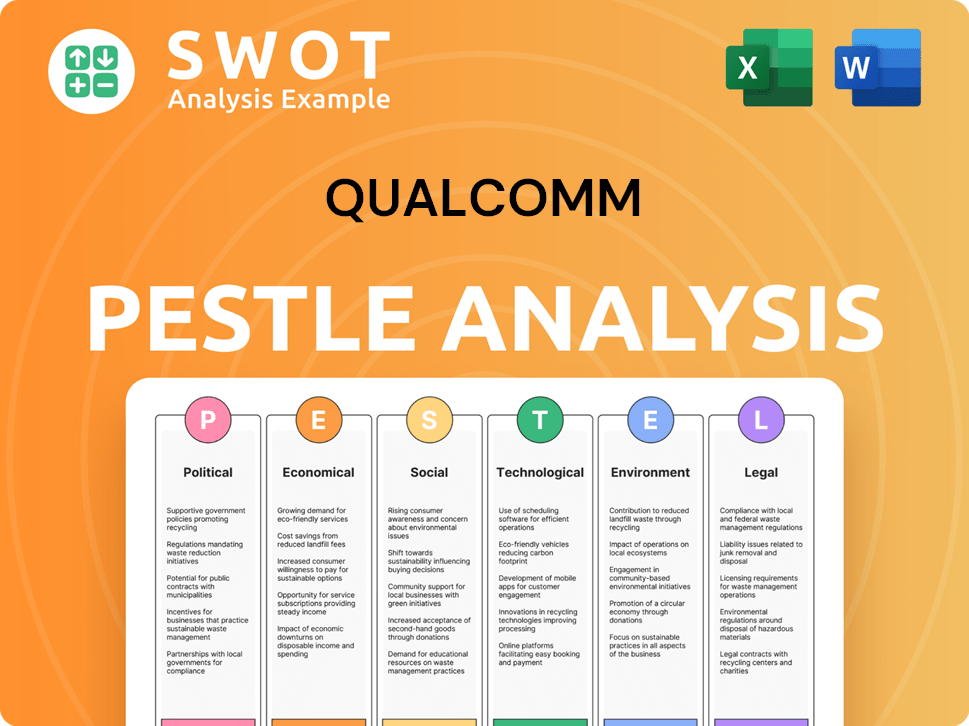
Who Sits on Qualcomm’s Board?
As of March 18, 2025, the Board of Directors of the company consists of 11 directors. The election of these directors is a key matter voted on by stockholders. The company operates under a one-share-one-vote system for all stockholder votes, including director elections. Decisions are generally made by a majority vote, unless otherwise specified by law, the company's Certificate of Incorporation, or Bylaws. Stockholders do not have cumulative voting rights.
The Board of Directors oversees the company's business operations and ensures alignment with its strategic objectives. The Board is also responsible for selecting and ensuring the continuity of executive management. While specific board members representing major shareholders aren't always detailed in public filings, the significant institutional ownership suggests that these large investors likely have a strong influence on board nominations and elections. The Governance Committee of the Board evaluates director nominees, seeking a diverse range of backgrounds and perspectives. Non-employee board members are required to hold common stock equivalent to five times their annual cash retainer within five years of joining the Board, aligning their interests with those of the shareholders. For more information, consider reading the Brief History of Qualcomm.
| Director | Title | Date Joined Board |
|---|---|---|
| Mark McLaughlin | Lead Independent Director | 2016 |
| Cristiano Amon | President and Chief Executive Officer | 2021 |
| Debra L. Reed | Director | 2011 |
In 2025, the strong institutional buying observed in the first quarter, with total institutional ownership reaching 74.35%, indicates a significant level of professional investor engagement. This substantial institutional presence allows for considerable influence over decision-making within the company. Large institutional investors can exert pressure on management and affect stock prices through their buying and selling activities. The company's market capitalization as of May 2024 was approximately $230 billion. The stock symbol is QCOM.
The Board of Directors oversees the company's strategic direction and executive management. Stockholders vote on key matters, including director elections, under a one-share-one-vote system. Institutional investors hold a significant stake, influencing decision-making.
- Board composition includes 11 directors.
- Majority vote determines most decisions.
- Institutional ownership exceeds 74%.
- Non-employee directors must hold significant stock.
Qualcomm Business Model Canvas
- Complete 9-Block Business Model Canvas
- Effortlessly Communicate Your Business Strategy
- Investor-Ready BMC Format
- 100% Editable and Customizable
- Clear and Structured Layout
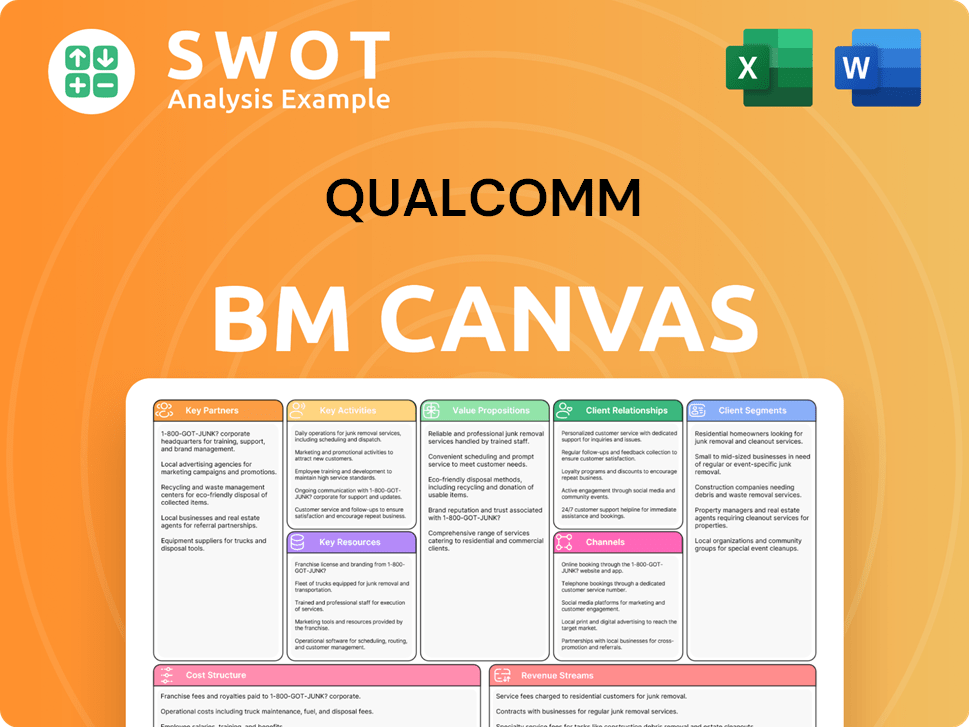
What Recent Changes Have Shaped Qualcomm’s Ownership Landscape?
Over the past few years, the ownership structure of Qualcomm has remained largely consistent, with institutional investors holding a significant majority of shares. As of June 2025, approximately 76.85% of Qualcomm is owned by institutional investors, with mutual funds accounting for 56.65% of the total shares. This indicates a strong level of confidence from major financial institutions. Conversely, insider ownership by Qualcomm executives and directors is minimal, decreasing slightly to 0.01% in June 2025.
Significant share buybacks have been a key strategy. For the quarter ending March 30, 2025, Qualcomm repurchased shares worth $1.74 billion. This follows similar buybacks of $1.75 billion in the quarter ending December 31, 2024, and $1.30 billion in both the September 30, 2024, and June 30, 2024, quarters. These actions reduce the number of outstanding shares, potentially increasing shareholder value.
| Ownership Type | Percentage (June 2025) | Recent Developments |
|---|---|---|
| Institutional Ownership | 76.85% | Consistent high percentage, reflecting confidence from major financial institutions. |
| Mutual Funds | 56.65% | Significant portion of institutional holdings. |
| Insider Ownership | 0.01% | Minimal direct stake by executives and directors. |
In terms of mergers and acquisitions, Qualcomm has been actively expanding its portfolio. On April 2, 2025, it acquired Movian AI, a generative artificial intelligence unit. Furthermore, in June 2025, Qualcomm agreed to acquire British semiconductor maker Alphawave IP Group for $2.4 billion. These moves reflect the company's strategic focus on high-growth areas like AI and automotive semiconductors. The global AI market is projected to reach $826.7 billion by 2030, which could significantly impact Qualcomm's future.
Institutional investors dominate Qualcomm's ownership. Mutual funds hold a significant portion of the shares. Insider ownership is minimal.
Qualcomm has been actively buying back its shares. These buybacks reduce the number of outstanding shares. The company's focus is on increasing shareholder value.
Qualcomm is expanding into AI and other key areas. The company acquired Movian AI and Alphawave IP Group. These acquisitions align with industry trends.
The market is showing a cautious yet confident view. The company's patent licensing draws regulatory scrutiny. For more insights, check out the Target Market of Qualcomm.
Qualcomm Porter's Five Forces Analysis
- Covers All 5 Competitive Forces in Detail
- Structured for Consultants, Students, and Founders
- 100% Editable in Microsoft Word & Excel
- Instant Digital Download – Use Immediately
- Compatible with Mac & PC – Fully Unlocked
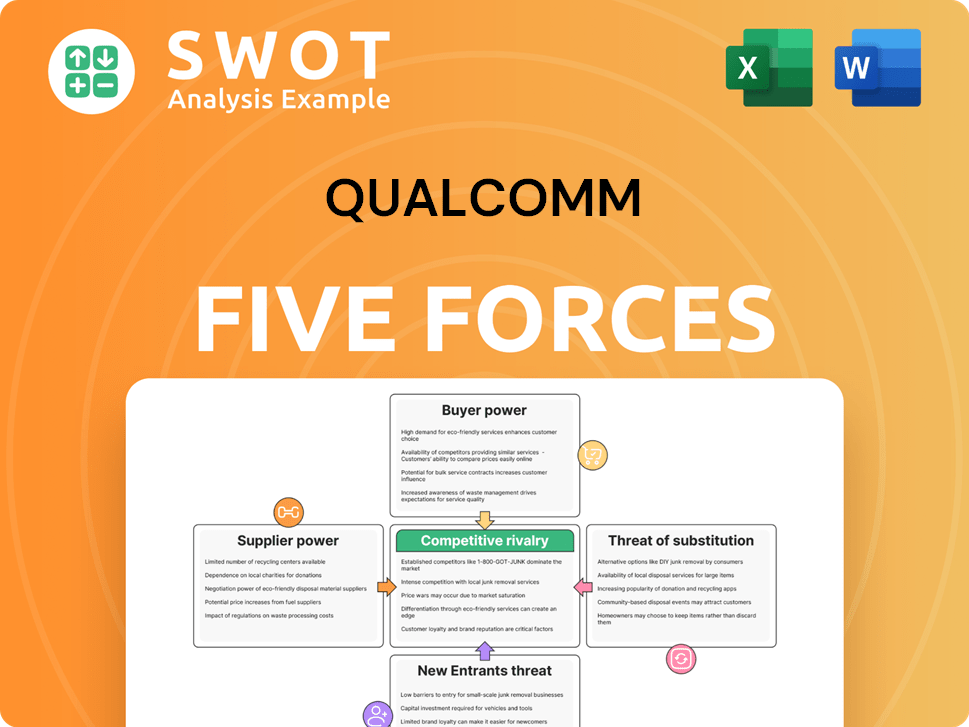
Related Blogs
- What are Mission Vision & Core Values of Qualcomm Company?
- What is Competitive Landscape of Qualcomm Company?
- What is Growth Strategy and Future Prospects of Qualcomm Company?
- How Does Qualcomm Company Work?
- What is Sales and Marketing Strategy of Qualcomm Company?
- What is Brief History of Qualcomm Company?
- What is Customer Demographics and Target Market of Qualcomm Company?
Disclaimer
All information, articles, and product details provided on this website are for general informational and educational purposes only. We do not claim any ownership over, nor do we intend to infringe upon, any trademarks, copyrights, logos, brand names, or other intellectual property mentioned or depicted on this site. Such intellectual property remains the property of its respective owners, and any references here are made solely for identification or informational purposes, without implying any affiliation, endorsement, or partnership.
We make no representations or warranties, express or implied, regarding the accuracy, completeness, or suitability of any content or products presented. Nothing on this website should be construed as legal, tax, investment, financial, medical, or other professional advice. In addition, no part of this site—including articles or product references—constitutes a solicitation, recommendation, endorsement, advertisement, or offer to buy or sell any securities, franchises, or other financial instruments, particularly in jurisdictions where such activity would be unlawful.
All content is of a general nature and may not address the specific circumstances of any individual or entity. It is not a substitute for professional advice or services. Any actions you take based on the information provided here are strictly at your own risk. You accept full responsibility for any decisions or outcomes arising from your use of this website and agree to release us from any liability in connection with your use of, or reliance upon, the content or products found herein.